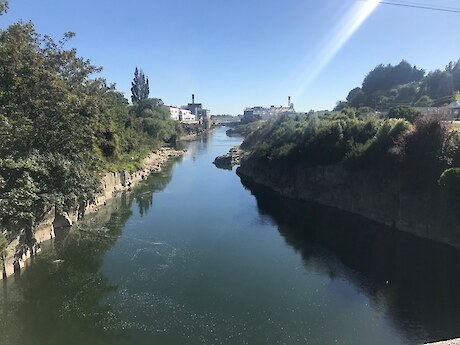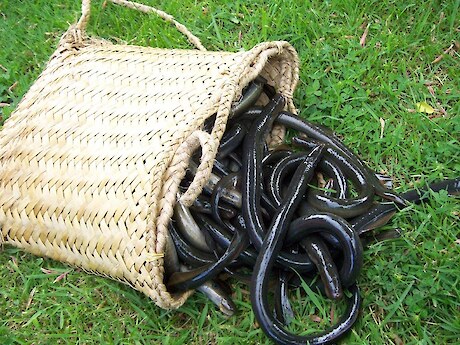Historical perspective
Ka tou rere ku ia E Paihere-kowao
Ta rereka te mata na Maraki
Ki te iwi e———–
The Mataura Valley has, for centuries, hosted trails known to many generations of southern Māori. The many names denoting landmarks, land forms, rivers and tributaries, attest to nearly a thousand years of continuous knowledge and understanding of the area.
From the earliest explorers such as Rakaihautu of the Uruao waka (canoe), Paiherekowao, Tamatea Ariki Nui of the Takatimu waka (canoe), the Waitaha (including Rapuai and Hawea people) who began the fires of occupation in the time of the giant flightless moa, to the coming of Kati Mamoe, and latterly Kai Tahu (Ngai Tahu) people.
Lasting deeds remembered
The deeds of prominent personalities are inextricably linked to local landmarks, and remembered today – those of Kati Mamoe chief Te Rakitauneke whose famous taniwha (dragon) Matamata now forms the profile of the Hokonui Hills, and Paroparo Te Whenua whose discovery of kakakana (lamprey) favoured the waterfalls at Mataura as a major seasonal food gathering site. These histories are punctuated also by the inconsolable grief of Weka, who acting on the loss of his wife Nuku and child on a hunting expedition in the northern reaches of the valley, composed a moving lament on the terrace of East Gore (a place known as Onuku).
Mataura River
 Mataura RiverThe Mataura River, along with its accompanying natural trails, guided early travellers from the pounamu (greenstone) fields of the west to the coastal regions of the east and south. The valley’s accommodating typography ensured regular visitations from both passing travellers and those gathering seasonal food (including eel, native trout, duck, weka, lamprey) and other commodities such as the highly valued stone, porcelanite - used for making knives. These trails were at times utilized by trading and marriage parties, and sometimes warriors seeking utu (revenge) to maintain their mana and control over local resources.
Mataura RiverThe Mataura River, along with its accompanying natural trails, guided early travellers from the pounamu (greenstone) fields of the west to the coastal regions of the east and south. The valley’s accommodating typography ensured regular visitations from both passing travellers and those gathering seasonal food (including eel, native trout, duck, weka, lamprey) and other commodities such as the highly valued stone, porcelanite - used for making knives. These trails were at times utilized by trading and marriage parties, and sometimes warriors seeking utu (revenge) to maintain their mana and control over local resources.
Mahika kai
 Kanakana (lamprey).Encampment sites denote many types of mahika kai (natural food gathering sites) available within the valley – Waikakahi (the Waikaka Stream flowing into the Mataura River) indicates a source of kakahi (freshwater mussel) and Te Au-nui Pihapiha Kanakana (the falls at Mataura) indicates a source of kanakana (lamprey) (see photo right). Other sites were well known and well used, such as Wharekorokio (a significant eeling encampment) at a site known locally as Pyramid.
Kanakana (lamprey).Encampment sites denote many types of mahika kai (natural food gathering sites) available within the valley – Waikakahi (the Waikaka Stream flowing into the Mataura River) indicates a source of kakahi (freshwater mussel) and Te Au-nui Pihapiha Kanakana (the falls at Mataura) indicates a source of kanakana (lamprey) (see photo right). Other sites were well known and well used, such as Wharekorokio (a significant eeling encampment) at a site known locally as Pyramid.
Travelling and landmarks
A number of prominent landmarks aided travellers with directional bearings. Some trails led specifically to notable food-gathering sites, others skirted around difficult terrain (such as the swamps at the site of Gore) while providing some limited food gathering opportunities for those en route to the settlements of Tuturau and those further south, or alternatively via the Mataura’s eastern banks and north-west towards Central Otago. East Peak (Hoka-nui), Pyramid Hill (Kowhaka-ruru) and West Dome (Tarahau-kapiti) were all important reference and surveillance points.
Inter-tribal combat
The late 18th and early 19th centuries saw struggles of ascendancy between factions of Kati Mamoe and Kai Tahu, culminating with the naming of significant battlegrounds such as Waitaramea near Five Rivers.
The only incursion into the territory of southern Māori by a northern tribe came via Ngati Tama chief Te Puoho’s raid of c.1836. His war party travelled the length of the South Island and followed the Mataura River south to capture the small settlement of Tuturau, only to be quickly repelled in what is regarded as the last instance of inter-tribal combat in New Zealand.
Contact with early European settlers
Subsequent to the unsuccessful raid by Te Puoho, Tuturau, the only permanent settlement in the Mataura Valley, became home to notable guide Reko. He was invariably the first point of contact and sole source of hospitality for early European surveyors charged with charting inland Southland and the southern lakes. Reko’s ability as a guide and his vast knowledge of the southern landscape was pivotal to the process of colonial exploration, and the accurate mapping of the inland regions of the lower South Island - in anticipation of pending European settlement.
